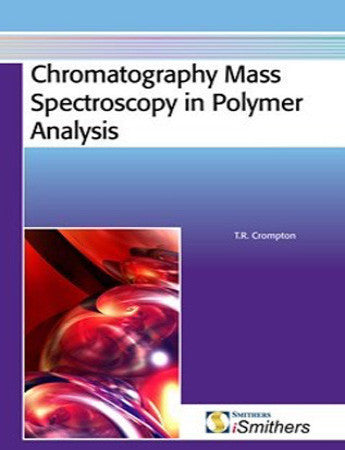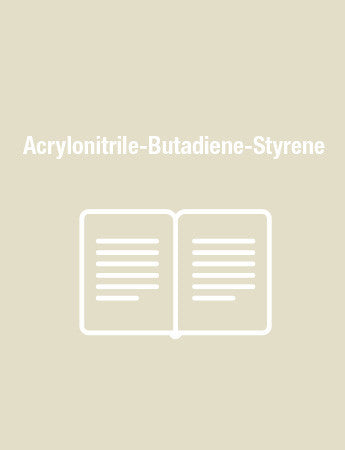Chromatography Mass Spectroscopy in Polymer Analysis
The combination of chromatography with mass spectroscopy is a very useful technique which is being increasingly used by polymer chemists to improve existing polymers and to discover new ones with specific physical properties such as thermal stability and retention of properties over a long service life.
This technique is extremely powerful for the analysis and characterisation of polymers and is often based on the use of controlled chromatography - mass spectroscopy to measure a polymer's decomposition with techniques such as pyrolysis, followed by chromatography to separate any breakdown product, and, finally, mass spectroscopy, to achieve an unequivocal identification of the pyrolysis products obtained. The detail that can be obtained by such methods includes structure of the polymer backbone, branching, end groups, isomeric detail and fine detail in the structure of copolymers.
The first three chapters of the book discuss the various chromatographic and mass spectroscopic techniques now available.
Chapters 3-8 cover the complementary methods, based on the combination of mass spectroscopy with various chromatographic techniques such as high-performance liquid chromatography, gas chromatography and supercritical fluid chromatography.
Pyrolysis chromatography-mass spectroscopy is a method of studying the structure of polymers which involves subjecting the polymer pyrolysis products to a chromatographic technique to simplify subsequent analysis and, finally mass spectroscopy to identify the pyrolysis products with the possibility of deducing finer details of polymer structure than were previously attainable by classical methods (Chapters 9-11).
By providing a thorough up-to-date review of work in this field it is hoped that the book will be of interest to all those engaged in polymer research and development, and polymer users in general.
This technique is extremely powerful for the analysis and characterisation of polymers and is often based on the use of controlled chromatography - mass spectroscopy to measure a polymer's decomposition with techniques such as pyrolysis, followed by chromatography to separate any breakdown product, and, finally, mass spectroscopy, to achieve an unequivocal identification of the pyrolysis products obtained. The detail that can be obtained by such methods includes structure of the polymer backbone, branching, end groups, isomeric detail and fine detail in the structure of copolymers.
The first three chapters of the book discuss the various chromatographic and mass spectroscopic techniques now available.
Chapters 3-8 cover the complementary methods, based on the combination of mass spectroscopy with various chromatographic techniques such as high-performance liquid chromatography, gas chromatography and supercritical fluid chromatography.
Pyrolysis chromatography-mass spectroscopy is a method of studying the structure of polymers which involves subjecting the polymer pyrolysis products to a chromatographic technique to simplify subsequent analysis and, finally mass spectroscopy to identify the pyrolysis products with the possibility of deducing finer details of polymer structure than were previously attainable by classical methods (Chapters 9-11).
By providing a thorough up-to-date review of work in this field it is hoped that the book will be of interest to all those engaged in polymer research and development, and polymer users in general.
1 Chromatographic Techniques
1.1 Gas Chromatography
1.2 High Performance Liquid Chromatography
1.2.1 Post-column Derivatisation: Fluorescence Detectors
1.2.2 Diode Array Detectors
1.2.3 Electrochemical Detectors
1.2.3.1 The determination of Monomers
1.2.3.2 Determination of Oligomers
1.2.4 Fractionation/Microstructure Studies
1.3 Size Exclusion Chromatography
1.3.1 Characterisation Studies
1.3.2 Branching
1.3.3 Compositional Analysis
1.3.4 Molecular Weight
1.3.5 Polymer Blends
1.3.6 Polymer Additives
1.4 Supercritical Fluid Chromatography
1.4.1 Polymer Additives
1.5 Thin Layer Chromatography
1.6 Thermal Field Flow Fractionation
vi
Chromatography Mass Spectroscopy in Polymer Analysis
2 Mass Spectroscopic Techniques
2.1 Time-of-Flight – Secondary Ion Mass Spectroscopy
2.1.1 Adhesion Studies
2.1.2 Polymer Interface Studies
2.1.3 Vulcanisation Studies
2.2 Matrix Assisted Laser Desorption Ionisation Mass Spectroscopy
2.2.1 Applications
2.3 Matrix Assisted Laser Desorption Ionisation Post
Source Decay
2.4 Electrospray Ionisation Mass Spectroscopy
2.5 Field Desorption Mass Spectroscopy
2.6 Tandem Mass Spectroscopy
2.7 Fourier-transform Ion Cyclotron Mass Spectroscopy
2.8 Fast Atom Bombardment Mass Spectroscopy
2.9 Radio Frequency and Glow Discharge – Mass Spectroscopy
3 Chemical Reaction Gas Chromatography
3.1 Applications
3.1.1 Saponification Procedures
3.1.2 Zeisel Procedures
3.1.3 Alkali Fusion
3.1.4 Reactive Hydrolysis – Methylation – Pyrolysis –Chromatography
4 Complementary High Performance Liquid Chromatography – Mass Spectroscopy
4.1 Theory
4.1 Applications Contents vii
4.1.1 Polymer Characterisation
4.1.2 Polymer Extractables
4.1.3 Determination of Polymer Additives
4.1.4 High Performance Liquid Chromatography –Infrared Spectroscopy
5 Complementary Size Exclusion Chromatography – Mass Spectroscopy
5.1 Applications
5.1.1 Molecular Weight
5.1.1.1 Polyesters
5.1.1.2 Poly(N-methyl Perfluoro –octylsulfonamido Ethyl Acrylate)
5.1.1.3 Polymethylmethacrylate
5.1.1.4 2-Benzothiozolon-3-yl Acetic Acid-telechelic Polyethylene Oxides (PEG Esters)
5.1.1.5 Polyesters
5.1.1.6 Polyethers
5.1.1.7 Hydrocarbon Types
5.1.1.8 Nitrogen Containing Polymers
5.1.1.9 Silicon Containing Polymers
5.1.1.10 Miscellaneous Polymers
5.2 Polymer Degradation Studies
5.3 End-group Analysis
6 Complementary Gas Chromatography – Mass Spectroscopy
6.1 Applications
6.1.1 Polymer Characterisation
6.1.1.1 Sulfur Containing Polymers
viii Chromatography Mass Spectroscopy in Polymer Analysis
6.1.1.2 3-Glycidoxyproply-tri-methoxysilane sols
6.1.1.3 Fluorine Containing Polymers
6.1.2 Polymer Degradation Studies
6.1.2.1 Low Molecular Weight Compounds or Degradation Products
6.1.2.2 Molar Mass Changes during Degradation Analysed by Size Exclusion Chromatography and/or Matrix Assisted Laser Desorption Ionisation
6.1.2.3 Polybutylene Adipate and Polybutylene Succinate
6.1.2.4 Rubbers
6.1.2.5 Polystyrene Peroxide
6.1.2.6 Polypropylene Hydroperoxides
6.1.2.7 Polystyrene
6.1.2.8 Polyethylene Oxide – Polypropylene Oxide Copolymers
6.1.3 Food Packaging Applications
6.1.4 Miscellaneous Polymers
7 Complementary Supercritical Fluid Chromatography – Mass Spectroscopy
8 Headspace Analysis – Mass Spectroscopy
9 Pyrolysis Gas Chromatography – Mass Spectroscopy
9.1 Applications
9.1.1 Polyolefins
9.1.1.1 Polyolefin Homopolymers
9.1.1.2 Polypropylene Carbonate
Contents ix
9.1.1.3 Polyolefin Copolymers
9.1.1.4 Polystyrenes
9.1.1.5 Polyesters
9.1.1.6 Chlorine Containing Polymers
9.1.1.7 Rubbers
9.1.1.9 Nitrogen Containing Polymers
9.1.1.10 Sulfur Containing Polymers
9.1.1.11 Silicon Containing Polymers
9.2 Polymer Additives
9.3 Miscellaneous
9.3.1 Py-GC-MS Methods
9.3.2 Direct Pyrolysis – Gas Chromatography without Intervening Chromatographic Stage
Abbreviations
Index
1.1 Gas Chromatography
1.2 High Performance Liquid Chromatography
1.2.1 Post-column Derivatisation: Fluorescence Detectors
1.2.2 Diode Array Detectors
1.2.3 Electrochemical Detectors
1.2.3.1 The determination of Monomers
1.2.3.2 Determination of Oligomers
1.2.4 Fractionation/Microstructure Studies
1.3 Size Exclusion Chromatography
1.3.1 Characterisation Studies
1.3.2 Branching
1.3.3 Compositional Analysis
1.3.4 Molecular Weight
1.3.5 Polymer Blends
1.3.6 Polymer Additives
1.4 Supercritical Fluid Chromatography
1.4.1 Polymer Additives
1.5 Thin Layer Chromatography
1.6 Thermal Field Flow Fractionation
vi
Chromatography Mass Spectroscopy in Polymer Analysis
2 Mass Spectroscopic Techniques
2.1 Time-of-Flight – Secondary Ion Mass Spectroscopy
2.1.1 Adhesion Studies
2.1.2 Polymer Interface Studies
2.1.3 Vulcanisation Studies
2.2 Matrix Assisted Laser Desorption Ionisation Mass Spectroscopy
2.2.1 Applications
2.3 Matrix Assisted Laser Desorption Ionisation Post
Source Decay
2.4 Electrospray Ionisation Mass Spectroscopy
2.5 Field Desorption Mass Spectroscopy
2.6 Tandem Mass Spectroscopy
2.7 Fourier-transform Ion Cyclotron Mass Spectroscopy
2.8 Fast Atom Bombardment Mass Spectroscopy
2.9 Radio Frequency and Glow Discharge – Mass Spectroscopy
3 Chemical Reaction Gas Chromatography
3.1 Applications
3.1.1 Saponification Procedures
3.1.2 Zeisel Procedures
3.1.3 Alkali Fusion
3.1.4 Reactive Hydrolysis – Methylation – Pyrolysis –Chromatography
4 Complementary High Performance Liquid Chromatography – Mass Spectroscopy
4.1 Theory
4.1 Applications Contents vii
4.1.1 Polymer Characterisation
4.1.2 Polymer Extractables
4.1.3 Determination of Polymer Additives
4.1.4 High Performance Liquid Chromatography –Infrared Spectroscopy
5 Complementary Size Exclusion Chromatography – Mass Spectroscopy
5.1 Applications
5.1.1 Molecular Weight
5.1.1.1 Polyesters
5.1.1.2 Poly(N-methyl Perfluoro –octylsulfonamido Ethyl Acrylate)
5.1.1.3 Polymethylmethacrylate
5.1.1.4 2-Benzothiozolon-3-yl Acetic Acid-telechelic Polyethylene Oxides (PEG Esters)
5.1.1.5 Polyesters
5.1.1.6 Polyethers
5.1.1.7 Hydrocarbon Types
5.1.1.8 Nitrogen Containing Polymers
5.1.1.9 Silicon Containing Polymers
5.1.1.10 Miscellaneous Polymers
5.2 Polymer Degradation Studies
5.3 End-group Analysis
6 Complementary Gas Chromatography – Mass Spectroscopy
6.1 Applications
6.1.1 Polymer Characterisation
6.1.1.1 Sulfur Containing Polymers
viii Chromatography Mass Spectroscopy in Polymer Analysis
6.1.1.2 3-Glycidoxyproply-tri-methoxysilane sols
6.1.1.3 Fluorine Containing Polymers
6.1.2 Polymer Degradation Studies
6.1.2.1 Low Molecular Weight Compounds or Degradation Products
6.1.2.2 Molar Mass Changes during Degradation Analysed by Size Exclusion Chromatography and/or Matrix Assisted Laser Desorption Ionisation
6.1.2.3 Polybutylene Adipate and Polybutylene Succinate
6.1.2.4 Rubbers
6.1.2.5 Polystyrene Peroxide
6.1.2.6 Polypropylene Hydroperoxides
6.1.2.7 Polystyrene
6.1.2.8 Polyethylene Oxide – Polypropylene Oxide Copolymers
6.1.3 Food Packaging Applications
6.1.4 Miscellaneous Polymers
7 Complementary Supercritical Fluid Chromatography – Mass Spectroscopy
8 Headspace Analysis – Mass Spectroscopy
9 Pyrolysis Gas Chromatography – Mass Spectroscopy
9.1 Applications
9.1.1 Polyolefins
9.1.1.1 Polyolefin Homopolymers
9.1.1.2 Polypropylene Carbonate
Contents ix
9.1.1.3 Polyolefin Copolymers
9.1.1.4 Polystyrenes
9.1.1.5 Polyesters
9.1.1.6 Chlorine Containing Polymers
9.1.1.7 Rubbers
9.1.1.9 Nitrogen Containing Polymers
9.1.1.10 Sulfur Containing Polymers
9.1.1.11 Silicon Containing Polymers
9.2 Polymer Additives
9.3 Miscellaneous
9.3.1 Py-GC-MS Methods
9.3.2 Direct Pyrolysis – Gas Chromatography without Intervening Chromatographic Stage
Abbreviations
Index




